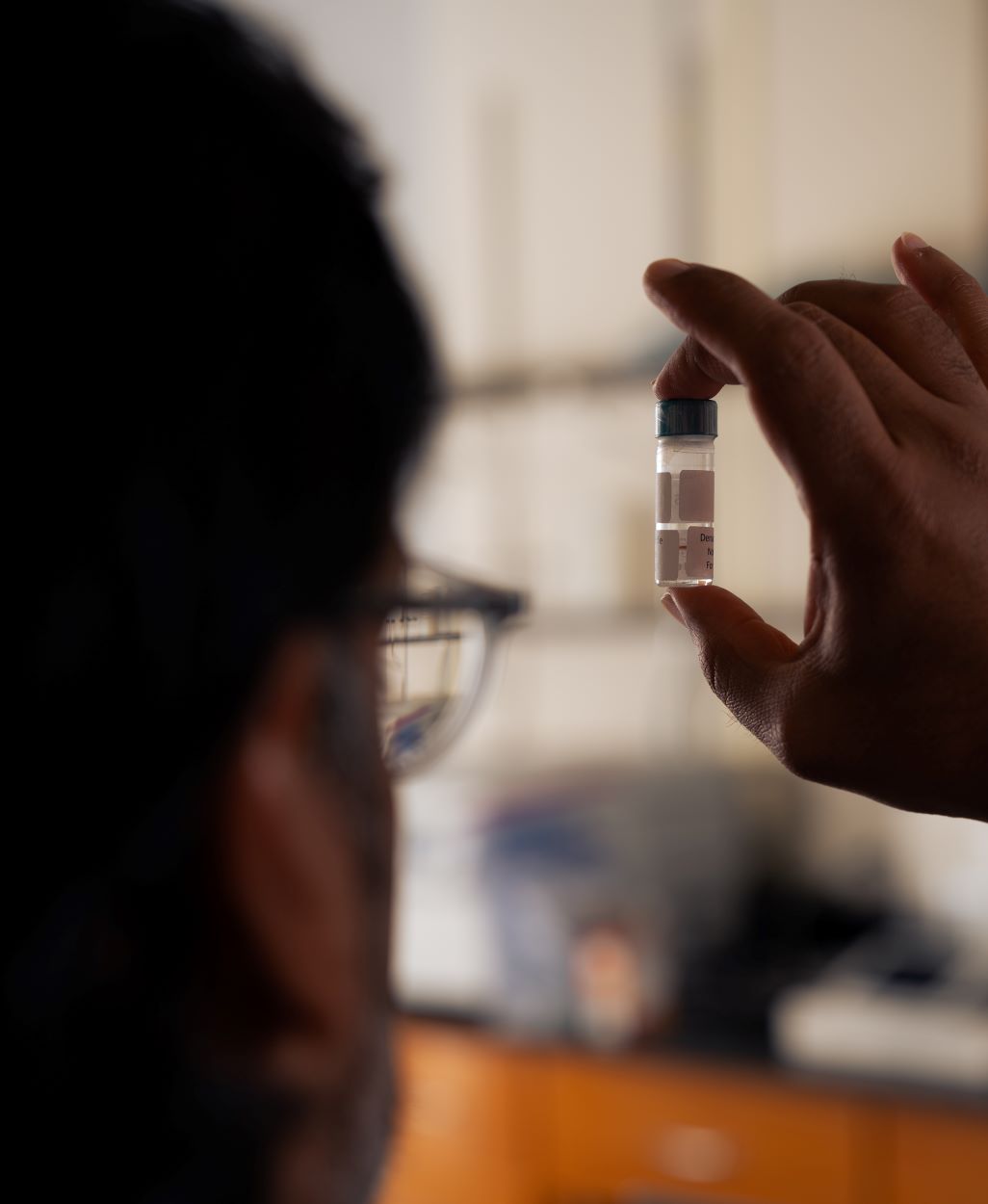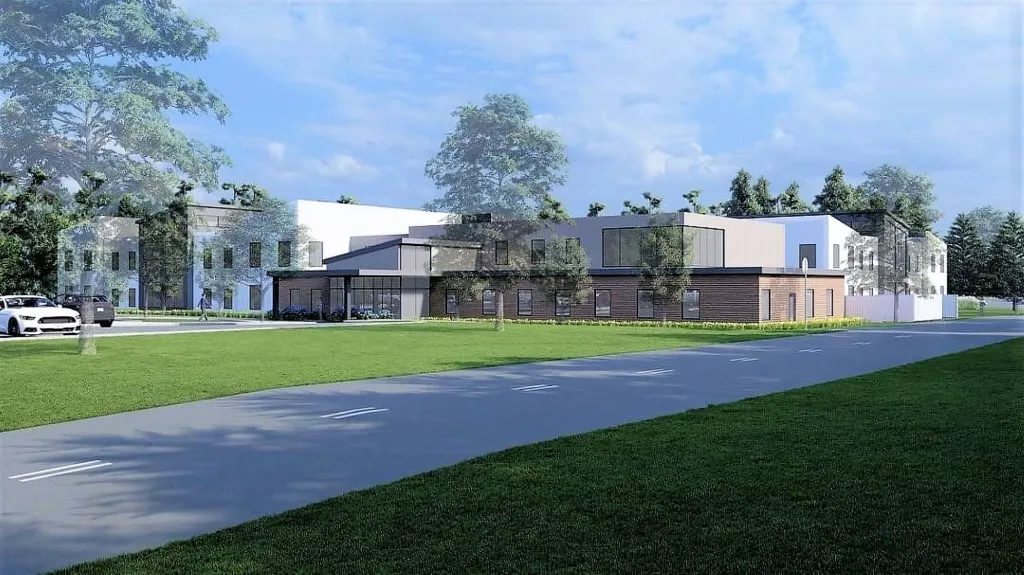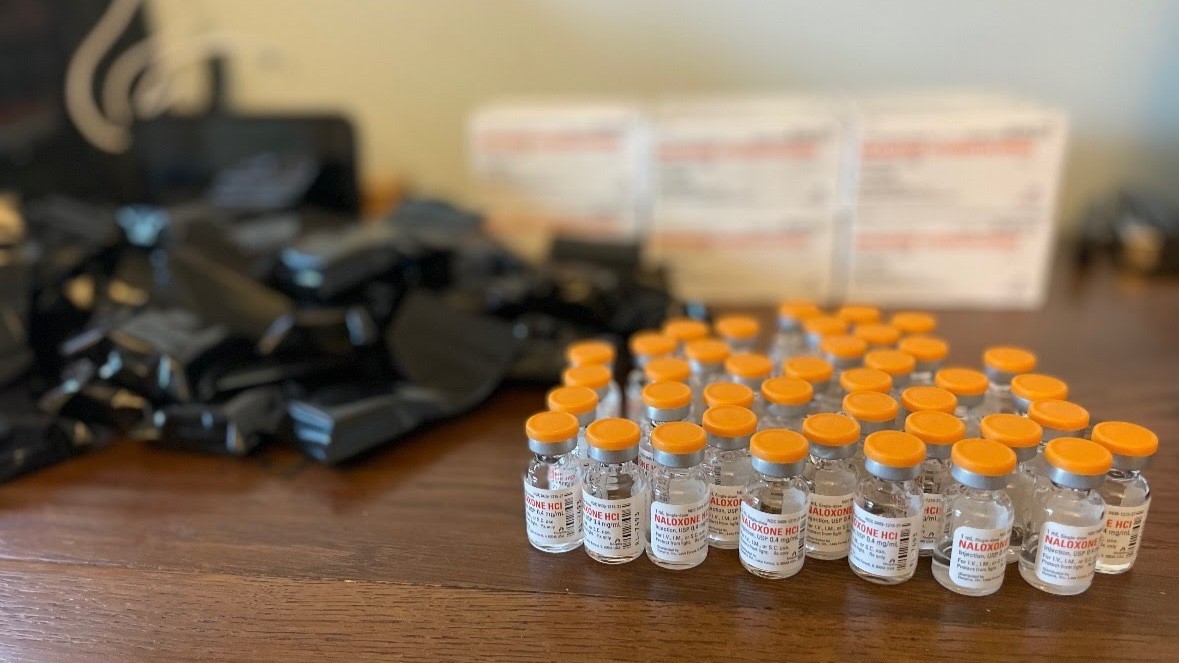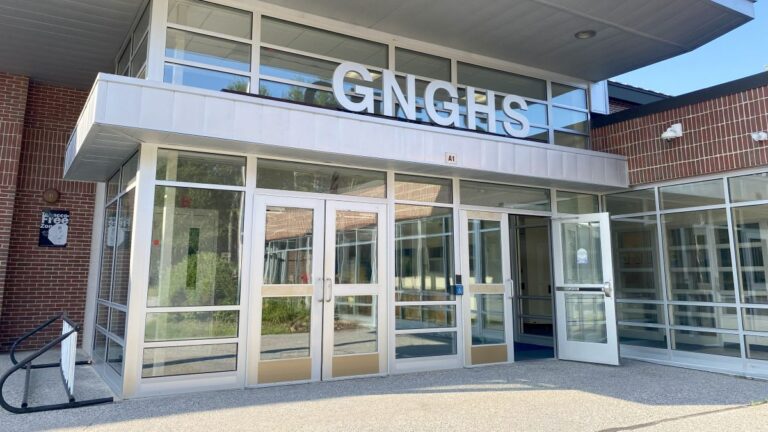Needle disposal boxes. Handheld spectrometers. Prevention programs for middle and high schoolers. Behavioral health workers. A 58-bed recovery center.
These are some of the ways that Maine counties, cities and towns have allocated the $8 million in opioid settlement funds distributed to them over the past two years.
The money is coming from settlements that capped years of litigation against prescription drug manufacturers, distributors and retailers accused of fueling the opioid epidemic that has claimed the lives of thousands of Mainers over nearly three decades.
Maine expects to receive about $230 million across 18 years from settlements with household names such as CVS Pharmacy and Walmart, and some of the biggest pharmaceutical companies in the country, like McKesson Corporation, Mallinckrodt, Allergan and more.
Nearly every medicine cabinet across the country likely has a drug made, distributed or sold by one of the settling companies.
A memorandum of understanding between the state, and the counties and municipalities that were part of a massive multidistrict litigation case against Purdue Pharma, divides Maine’s portion of the more than $50 billion being doled out nationally, into three shares: Twenty percent to a state fund overseen by the attorney general’s office; 50 percent to a recovery fund, overseen by the Maine Recovery Council; and 30 percent to a subdivision fund paid out directly to 39 counties, cities and towns.
There is little oversight for how localities — which were party to the Purdue litigation or have a population of at least 10,000 — spend their cut of the money, which will amount to more than $66 million by 2038.
They are supposed to adhere to a list of allowable uses, but neither the memorandum nor settlement agreements require the subdivisions to report expenditures to the public or state.
Without disclosure requirements, Mainers have little way of knowing how their local governments are making spending decisions.
In an attempt to shed light on their choices, The Maine Monitor reached out to officials from each subdivision with a detailed list of questions — ultimately hearing back from everyone but Brunswick, Waterville, and Somerset and Washington counties.
Officials from the 35 counties, cities and towns that responded to The Monitor’s survey described putting the funds toward a wide variety of initiatives, some focused on prevention and awareness, others on treatment and recovery.
One theme was particularly prominent: A third of the subdivisions reported spending money on law enforcement and jail programs, including medication-assisted treatment (MAT) for substance use disorder in jails, a priority for advocates. But it also includes hiring behavioral health specialists that work with police, and purchasing handheld drug-checking devices.
Decisions to fund police programs and services technically comply with the MOU, but are at odds with how most advocates say the money should be spent.
A nationwide coalition of more than 130 public health groups, legal aid organizations and providers last year issued a list of priorities for the settlement money.
The coalition, which included Maine Access Points, Maine People’s Alliance and the Maine Recovery Advocacy Project, warned against spending on “law enforcement personnel, overtime or equipment.”
Instead the group recommended spending to expand access to medication-assisted treatment, increase housing access and support community-based organizations doing on-the-ground work.
Drug-checking devices
Saco and Falmouth purchased handheld drug-checking devices for their police departments. Saco bought the TacticID-N Plus and Falmouth got the TruNarc. These instruments, called Raman spectrometers, cost around $25,000 apiece. Saco and Falmouth each used nearly $20,000 of their opioid settlement money to help pay for them.
Experts have questioned the accuracy of the tools.
“Those handheld devices are worse than bad, they are plain dangerous,” Dr. Nabarun Dasgupta, a senior scientist researching street drugs at the University of North Carolina’s school of public health, told The Monitor.
Dasgupta called the TacticID-N Plus and TruNarc devices “garbage.”
They use a technology called Raman spectroscopy — which uses light beams to identify molecular structures — to determine which drugs are present in a sample. Dasgupta said the process works “fine” when dealing with one or two substances.
“But when you get into mixtures of substances, which most street drugs are, they’re not effective, they miss substances and they can give false positives,” he said. “They’re not scientific tools. They’re legal tools for cops to be able to arrest people.”
Saco Police chief Jack Clements and Falmouth Police deputy chief Jeff Pardue told The Monitor their departments purchased the devices because they allow officers to test a substance without taking it out of its container, which is helpful for “officer and victim safety.”
They can quickly and accurately identify substances in an overdose situation; and their results can be used in criminal proceedings.
Both named concerns about officers’ safety as a major consideration. If a drug such as fentanyl becomes airborne or gets on an officer’s skin, it can “overcome” the officer, Clements said.
In 2017, the U.S. Drug Enforcement Administration released a warning about fentanyl exposure. “Any fentanyl exposure can kill innocent law enforcement, first responders and the public,” said Rod Rosenstein, the deputy attorney general at the time.
But such “exposure overdoses” have been debunked by clinicians and medical toxicologists.
“This has never happened,” Dr. Ryan Marino, a toxicologist and emergency medicine physician who researches addiction at Case Western Reserve University in Ohio, told NPR last year. “There has never been an overdose through skin contact or accidentally inhaling fentanyl.”

The police officials also said it helps their departments’ community resource liaisons direct people toward appropriate treatment options, though they said that largely happens through the court system.
Dasgupta, who is also the co-founder of Remedy Alliance For The People — a nonprofit that supplies low-cost naloxone to harm reduction programs — said having real-time information on drugs can be helpful, especially for medical providers establishing a treatment plan, but he doesn’t think the Raman spectrometers are appropriate for collecting data.
There are more accurate options available that are already being used in Maine: Project DHARMA, a federally funded harm reduction program, has deployed portable Fourier transform infrared (FTIR) spectrometers with organizations statewide to learn more about what’s in the drug supply.
These machines, called the Nicolet Summit PRO, are made by Thermo Fisher, which also makes the TruNarc. Maine Access Points has two machines, and commonspace in Portland and Church of Safe Injection in Lewiston each have one.
At about $20,000 per machine, they are cheaper and more accurate than TruNarc and TacticID-N Plus, advocates say.
“If you’re opting for (the TruNarc or TacticID-N Plus), that tells me that you are using that during traffic stops, you’re using that during raids,” said MAP’s operating director, Whitney Parrish Perry. “And that does not feel like the spirit of the funds to me.”
Police programs
A number of subdivisions use their money to fund behavioral health liaison positions within police departments. Brunswick, Falmouth, Gorham, South Portland, York and Sagadahoc County have spent or allocated nearly $370,000 combined to fund positions.
The town of York, for instance, allocated more than $92,000 for a contract with York County Community Action Corporation for two community health workers and one caseworker who will “help address challenges with opioids in the community,” said human resources director Kathryn Lagasse.
In a preliminary budget, Gorham town manager Ephrem Paraschak proposed creating a community liaison position within the police department that will be “100 percent funded through opioid settlement funding that is available for the next 10 years.” He requested $77,085 for fiscal year 2024-25.
South Portland spent nearly $62,000 to hire an additional behavioral health liaison for its police department, finance director Ellen Sanborn said, and allocated $106,500 to continue funding the position into the next fiscal year.
Sanford city manager Steve Buck told The Monitor that the city’s plan to use the money to “offset the cost of the police department’s mental health unit” hasn’t changed since last year. Buck’s preliminary budget proposed using $123,300 of the funds toward the mental health unit. The city spent $114,450 in fiscal year 2023-24.
Lewiston, meanwhile, spent $37,000 on a new vehicle for a ridealong program that pairs a mental health counselor with Lewiston and Auburn public safety officers.
Treatment in jails
Administrators from several counties said they expect to spend most of their funds on prevention and treatment programs in jails.
Androscoggin County, for example, has spent or allocated more than $346,000 on “mandated substance use disorder programs in jail,” deputy county administrator Clarice Proctor said.
Piscataquis County, meanwhile, has put nearly $43,000 toward hiring a medical technician to administer medications that treat substance use disorder, pay for the prescriptions and provide counseling for jail residents, according to county manager Michael L. Williams.
Penobscot County administrator Scott A. Adkins said officials have spent $26,000 on prevention services at the county jail, and allocated another $1.05 million for these programs, but did not provide detail on what the services entail.
Programs at the jail are “currently the only projected use of funds,” he said.
Hancock County contracted Aroostook Mental Health Services to provide services at the county jail for 12 months at a total cost of $36,000, according to administrator Michael Crooker.
Kennebec County is spending its share on medication-assisted treatment at the county jail, which administrator Scott Ferguson called a “$1 million unfunded mandate passed in the legislature.”
Gov. Janet Mills signed an executive order in 2019 that directed the Department of Corrections to develop a pilot program to provide medication-assisted treatment to inmates and to “encourage every county jail to have MAT services available for incarcerated Mainers suffering from substance use disorder, and help individuals receive similar services after their release.”
A month later, a federal judge ruled that the Aroostook County Jail had to provide MAT to a Madawaska woman, which was upheld on appeal.
In 2022, Mills signed a bill that required county jails to provide medication for substance use treatment and established a County Jail Operations Fund to help pay for it. The governor’s supplemental budget for 2024-25 includes $4 million for MAT services.
Needle disposal
Bangor will spend an estimated $30,000 per year on a syringe litter pickup service, city manager Debbie Laurie said. This decision was made as the city opposed attempts by a new state-certified syringe service program, Needlepoint Sanctuary, to operate in parts of town.
Of the more than $286,000 Lewiston has distributed or allocated, the city spent just under $2,000 to replace needle disposal boxes.
Recovery centers and housing assistance
York County commissioners approved spending all of their settlement funds — $4.6 million — to build a 58-bed regional recovery center in Alfred.
Penobscot County distributed $14,500 to Breaking the Cycle, a recovery home for women in Millinocket, for “capital improvement to their facility,” the county administrator said.
Westbrook has spent nearly $64,000 on in- and outpatient treatment, recovery housing, medical services, food insecurity and prevention costs, police captain Steven Goldberg said.

Lewiston has allocated $11,600 to A Hand Up Recovery & Re-Entry Housing, an organization working to provide housing for people transitioning out of the prison system.
Cumberland County used $21,230 last spring to fill in a funding gap for Pathways of HOPE, formerly Operation HOPE, between state Department of Safety grant periods.
The project, formerly run by Scarborough Police and now a partnership between the Cumberland County public health department and the Portland Recovery Community Center, works to support people at high risk of overdose and criminal justice involvement by helping them find treatment and housing, according to the county’s public health director, Liz Blackwell-Moore.
Scarborough has put some of its funds toward short-term housing for individuals affected by substance use disorder while they work with a police department social worker to connect to longer-term services, Scarborough Police social services navigator Lauren Dembski-Martin said.
Community support
Lewiston has allocated $27,400 to nonprofit An Angel’s Wing to establish a community support and receiving center; $23,000 to Recovery Connections of Maine for recovery coaching in St. Mary’s Medical Center’s detoxification unit; $18,000 to Sweetser for training to increase effective treatment options for youth and their families, and $166,400 to Tri-County Mental Health Services to contract counselors for Project Support You. Portland-based Spurwink acquired TCMHS this year.
Franklin County commissioners awarded $10,000 to Kennebec Behavioral Health, which plans to use the money for recovery coaches and gas cards, and $10,000 to Western Maine Community Action for staffing at its recovery center, county administrator Amy Bernard said.
Cumberland County has allocated $80,000 for one to two treatment programs solicited through a request for proposals that closed last month.
Research and awareness
Cumberland County spent $4,790 to host a day-and-a-half “sequential intercept mapping” workshop in March.
Blackwell-Moore said 75 people working in behavioral health and criminal justice systems in Cumberland County “developed a comprehensive community-wide strategic plan for addressing substance use, particularly among adults involved in the criminal legal system.”
The county was one of the 11 nationwide selected to host a workshop, which was facilitated by the federal Substance Abuse and Mental Health Services Administration.
The county is also spending about $90,000 combined this fiscal year and next to partially fund a behavioral public health manager within the public health department to build relationships with, and assess efforts and opportunities for “enhancing coordination among programs and agencies that serve people who use drugs,” Blackwell-Moore said.
Lewiston put $1,000 toward its annual Rally for Recovery, while Waldo County gave $2,000 to Belfast Creative Coalition for an awareness campaign.
Prevention initiatives
Windham has spent $9,000 on substance use prevention programming at its middle and high schools, according to the town manager’s executive assistant, Tammy Hodgman.
Cumberland County has allocated but not yet disbursed $40,000 for a “preventative intervention program for families, youth and adolescents at risk for opioid use disorder, and any co-occurring substance use disorder/mental health conditions,” according to Blackwell-Moore.
The county plans to apply for federal, state and philanthropic grants to pay for the bulk of the program and use the opioid settlement money as a complement.







